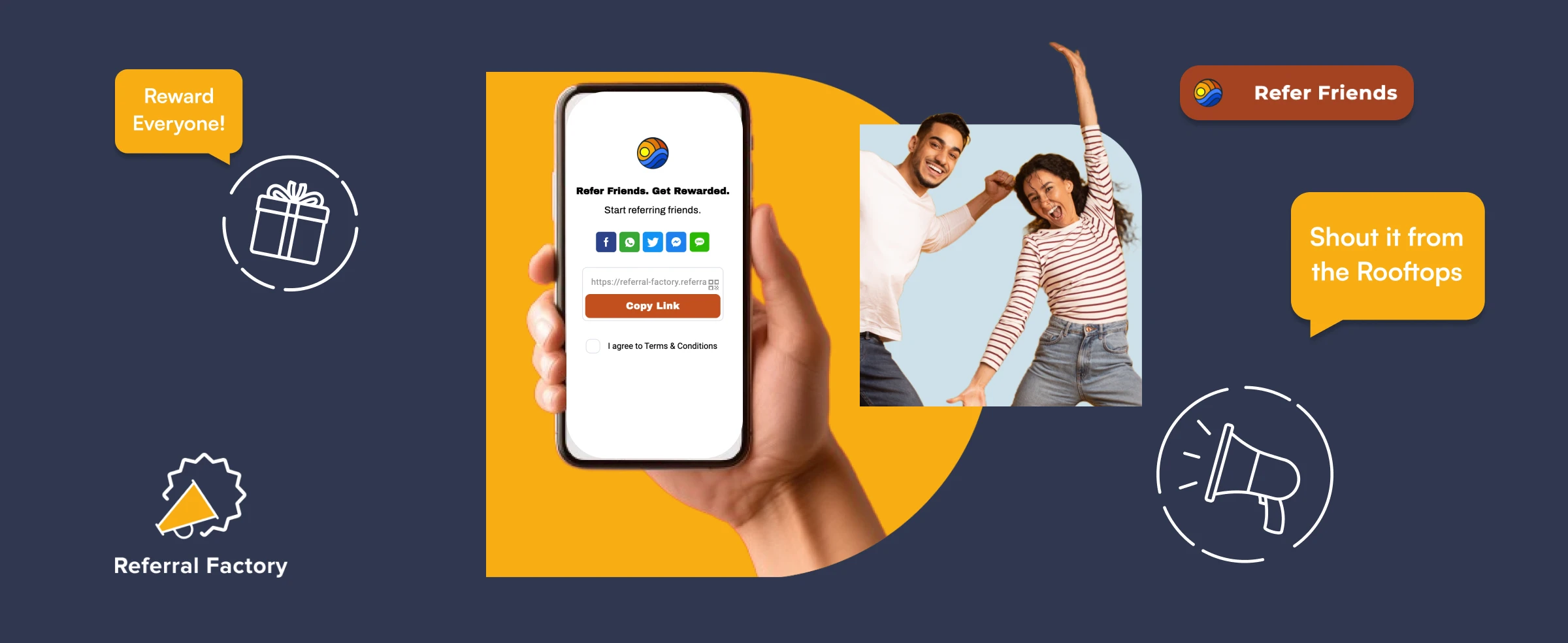What Is A Referral Code? 7 Examples + How To Make Them
Are you looking for an effective way to accelerate growth in your business? Heard something about referral marketing but still wondering what is a referral code and how to get one for your customers?
Here’s the scoop: referral marketing is where you ask your current customers to refer their friends, and if they do so, you reward them for sending new business your way. To track these referrals (to know which customers referred their friends) you’d use referral codes or referral links.
In this article, we’ll talk you through what is a referral code, how to create referral codes for your customers (using referral program software) and how to actually prompt them to refer their friends.
Keep reading if you’d like to get more referrals and grow your business in 2024 🚀
Or, if you’d prefer, watch this explainer video:
Table of Contents
What Is A Referral Code?
A referral code is a unique combination of letters or numbers that identifies and connects participants in a referral program. It acts as a key that unlocks rewards or incentives when used by someone to refer others to a particular product, service, or business.
Put even more simply, a referral code is what your customer would share with a friend they want to refer. If that friend then uses that code on checkout or sign-up (often to redeem a discount or bonus), you can track who that referral code belongs to.
The biggest use case for referral codes is in influencer marketing 👇

How Does A Referral Code Work?
Referral codes work by serving as digital keys, typically unlocking exclusive benefits for both the referrer and the referred individual. Promotional campaigns where people give out referral codes are often called ‘refer a friend programs‘.
When an existing customer shares their unique referral code with a friend, family member, or colleague, they essentially extend a personal invitation to experience your product, service, or business.
Here’s a step-by-step breakdown of how a referral code works:
STEP 1: Sharing the Code
The process begins when a satisfied customer shares their referral code with someone they think would benefit from your offerings. This can be done through various channels, including social media, email, or messaging apps.
STEP 2: Redemption
The recipient of the referral code, intrigued by the recommendation, uses the code during checkout or sign-up. This step is crucial, as it signifies the conversion of a potential lead into an actual customer.
STEP 3: Referral Tracking and Validation
As the referral code is entered, your system recognizes it, attributing the referral to the original customer. This method of referral tracking ensures the referrer is accurately credited for their successful referral.
STEP 4: Rewards and Incentives
Upon successfully redeeming the referral code, the referrer and the new customer are typically rewarded. This reward system shows appreciation to the existing customer for their advocacy and incentivizes the new customer to purchase, fostering brand loyalty.
Why Referral Codes Are The OLD Way To Track Referrals
Referral codes have long been popular for businesses to track and reward customer referrals. Customers share these unique codes with their friends and family, who then enter them during checkout or sign-up to receive incentives or discounts.
This method works but has been improved over time to make the act of referring more personalized and more likely to be successful.
Marketers also sought ways to overcome the drawbacks of using referral codes to manage their referral programs.
Drawbacks of using only referral codes include:
❗️ Referral codes require customers to remember and manually input these often random or complex codes, which can be cumbersome. More often than not, they forget or lose the codes by the time they are ready to buy.
❗️ Referral codes don’t work with longer sales cycles because – as mentioned above – they get forgotten if not used instantly.
❗️ Referral codes also don’t provide a personalized experience. For example, if I provide my friend with a referral code, they still have to figure out how to get to the business’s website, and once they do, there is no personal message inviting them to become a customer.
Here are some examples of referral codes in use:


In both cases, you’ll see the limitations – the influencers, affiliates or existing customers share their codes on social media but give no information about how to use them.
This works well when there is a strong existing brand awareness but for most regular businesses this can result in a missed opportunity because the promotional codes get seen but potential customers can’t figure out how to use them.
To push the person invited from interested to purchasing, you should make sure it’s clear how to use the codes and where to go to redeem them!
Why Referral Links Are The NEW Way To Track Referrals
Referral links give each referrer a dedicated landing page to invite their friends to your business.
This personalized landing page is tailor-made for the referrer, simplifying the promotion of your business and the tracking of their referrals.
Moreover, these landing pages allow you to create enticing ‘offers’ that customers can readily share with their friends to accept or unlock.
Referral links allow you to make a much more personalized referral experience, giving you much more control as a business about what you offer the person being invited.
Imagine referral links as personal invitation pages that your referrers share with their friends. Here are some referral program examples, showing participants’ referral links in action:


In customer referral programs, opting for referral links offers numerous advantages over using referral codes. Firstly, it creates a more streamlined experience for referrers and their friends.
Referrers no longer need to bother remembering and sharing complex codes; instead, their friends can simply click on the link, effortlessly visit your site, and purchase.
Moreover, implementing referral links simplifies the tracking and rewarding of successful referrals.
Each referrer receives a dedicated landing page, enabling you to easily monitor the number of referrals they’ve generated and determine their eligible rewards.
Another compelling reason to choose referral links over codes is the ability to gauge the exact reach of each referrer’s efforts.
Tracking codes can be challenging, as you only discover that a code has been shared once the referred individual uses it during checkout. In other words, you only know about a referral AFTER conversion, AFTER the sale has been made.
In contrast, a referral link allows you to track crucial metrics for each referrer, such as reach, referrals, and converted referrals. This means you ALSO get to see leads and potential sales, which means you can do what you need to do to encourage that lead to convert.

In essence, using a referral link as your tracking mechanism is a strategic move for any business seeking growth through word-of-mouth marketing. Referral links work well for businesses who have longer sales cycles or don’t use digital checkouts.
By offering customers an effortless way to share your business with their friends, you can effortlessly generate new referred leads that already trust your brand.
You can generate referral links (or referral codes) for:
✅ Your customers
✅ Your affiliates
✅ Your employees
✅ Your influencers

How To Create Referral Links For Your Customers
To create referral links, begin by creating an account on Referral Factory. This platform will provide you with the necessary tools and features to generate unique referral links for your customers.
Once your account is set up, use a referral marketing program template to create your referral program. You’ll need to set up a referral campaign to create unique links for each user.
Launching a formal referral program is how you effectively communicate with your customers, how to refer friends, and how they will be rewarded.
Use A Referral Program Template To Launch A Campaign
Why waste time and effort starting from scratch when you can use an expert-designed refer-a-friend program template to launch your campaign?
You can create a referral program for as little as $95 per month, and with access to over 100 referral program templates, you’ll be up and running in no time.
These campaign templates offer you an out-of-the-box ‘referral strategy’. Your referral campaign will be more likely to succeed if you start with templates.
Trust us. You can fully customize each template with your brand’s colors, fonts, assets like images and videos, and more, creating a seamless referral experience for your customers.
Easily Track Each Participant’s Referral Link
Tracking referral links is crucial for the success of your referral marketing campaigns. By monitoring and analyzing the data and metrics from these tracked links, you can gain valuable insights into the performance of your marketing efforts.
Setting up link tracking in Referral Factory is a simple process that allows you to easily track all your users’ referral links/ codes.
This combination of code tracking and campaign analysis empowers you to optimize your strategies and maximize the impact of your advocate-driven promotions.
How To Create Referral Codes For Your Customers
When creating a referral code, you can generate them randomly or sequentially.
Random codes offer higher security and are less predictable, while sequential codes can provide a sense of order and organization.
Consider your specific needs and preferences when deciding which method to use for creating referral codes.
Here is a referral code example of a random code: 8ja02hal2
Here is a referral code example of a sequential code: Robert10
Upgrade Your Digital Checkout To Accept Referral Codes As Coupons
To effectively utilize referral codes, it’s crucial to upgrade your digital checkout system to accept them (the same way you accept coupon codes).
This functionality allows customers to easily redeem their referral rewards while purchasing, enhancing the overall user experience and encouraging more referrals.
You must also consider the experience; for example, once a referral code is entered, you need to show the buyer that you recognize the code and have applied the promised discount.
(P.S. If you’re not an e-commerce business and don’t have a digital checkout system, this is a great clue that you should rather use referral links to track your referral program!)
Create Email Notifications To Update Both The Person Referring And The Person Invited About Referral Code Usage
Keeping both the referrer and invited person informed is essential for an effective referral program. Create email notifications that automatically update both parties about any progress or updates related to their referrals.
For example, if John refers to Kim, and Kim uses her referral code, then both parties should receive an email notification letting them know the referral has been successful. This ensures transparency, builds trust among participants, and encourages continued engagement in your referral program.
TIP: If you use referral marketing tools or software, these emails should be included and automated for you.
How Can You Control The Expiry On Referral Codes (and Links)?
The presence or absence of an expiration date on the actual referral code depends on the campaign strategy and rules of the actual referral program.
While some businesses create expiration dates on their referral codes, others may choose to keep them active indefinitely.
With referral links, it’s much simpler to control the expiry date because you can turn the links on and off at any point – usually, this control sits inside your referral program software. And, since a referral link leads to an easily customizable landing page, it’s easy to notify people whether the promotion is still running in a professional way.
With referral codes, it’s not quite as simple. You MUST set the expiration dates before issuing the codes, as this cannot be controlled at a later stage.
Here are the main reasons you should consider putting an expiry date on every referral code that is issued:
Promotional periods always come to an end: Referral codes may be part of a limited-time promotion, allowing businesses to drive short-term sales and create a sense of urgency among customers. By setting an expiration date, businesses can encourage customers to take immediate action and refer more individuals within a specific timeframe.
Inventory management: Referral codes that offer discounts or free products may have expiration dates to ensure that the business can manage its inventory effectively. By limiting the availability of promotional items, businesses can avoid running out of stock of special items or rewards that have been promised to users.
Tracking and analytics: Expiration dates on referral codes can help businesses track the effectiveness of their referral programs and measure their return on investment for each code. By analyzing the referral codes’ performance within a specific timeframe, businesses can make data-driven decisions and optimize their referral marketing strategies accordingly.
When is the right time to issue referral codes to your customers?
Let’s acknowledge the fact that we all lead busy lives, managing one marketing campaign after another! Therefore, it becomes crucial to ensure that your business is well-prepared for initiating a referral program (or issuing referral codes).
By doing so, you can maximize your efforts and ensure a positive return on investment for every referral code or referral link you issue.
Below, we’ve compiled a list of factors to consider when deciding whether your business is ready to issue referral codes or referral links.
You want to make sure your business is ready to execute a referral marketing strategy before you kick-start the process. The reason for this is to be sure that all your effort in setting up a referral program is MOST likely to deliver a positive ROI. You want to know that once you start issuing each referral code, you’re going to get something in return!
These are the factors to consider before launching your referral program:
Do you offer an excellent product or service?
The foundation of a successful referral program lies in the quality of what you are offering. Your product or service should efficiently solve the customer’s problem and leave them delighted with their experience.
Customers are more likely to recommend something if they have had a positive experience. In essence, having a great product/service leads to happy customers who, in turn, become more inclined to refer to others. Sharing a referral code is an easy ask ONLY IF you delivered great customer service and experience.
A key indicator here is if you see a solid uptake in your loyalty program or if you have good reviews. If customers are loyal to you and come back time and time again, it’s highly likely that they will be comfortable sharing their referral codes on social media or their referral links with their friends!

Do you have an existing customer base?
While you might have been the first customer and referrer for your business as its owner, for your business to thrive, it requires more than just your patronage.
The same applies to launching a referral program with referral codes. The larger your customer base, the more advantageous it becomes to leverage network effects, where the value of your referral program increases as you have more existing customers.
Having at least 100 to 1000 existing customers is recommended to fully benefit from a referral program, with the specific number depending on market factors and your price point. The more customers you have, the better the results you can expect from your referral program.
It’s pretty simple to understand – if 500 people share their referral codes with a friend, it will drive a lot more value than if 5 people share their referral codes with a friend.
If you still have a small base of customers and you’re just starting out, don’t worry so much about code links and referral software – just pick up the phone, call your customers, and convince them to spread the word. Your early customers are the origin of your business; don’t be afraid to speak to them. You can also learn more in this guide to referral programs for small businesses.
Are your existing customers engaged?
The quantity of customers is important, but so is the quality of their engagement with your business.
Having thousands of social media followers or a substantial email list is insufficient if those individuals are not actively engaged with your brand.
Engaged customers are more likely to share a referral code with others because they have a deeper connection and interest in your products or services.
To gauge customer engagement, consider the key benchmarks for primary digital marketing channels, such as the percentage of people who take specific actions (e.g., sharing, opening, commenting, or liking) in relation to the number of people who see your content.

Have you invested in paid advertisements?
If you have previously used platforms like Google, Facebook, or LinkedIn for paid advertising to promote your business and offerings, it can be beneficial when starting a referral program.
Paid advertising provides a benchmark for your Customer Acquisition Cost (CAC), which is the expense of converting a potential customer into a paying one.
Knowing your CAC can help you figure out the budget for the rewards or incentives for your referral program. Generally, the value of these rewards should be lower than the cost of converting a customer through paid ads.
This knowledge can also be used to create a double-sided referral system, offering rewards to both the referrer and the newly-referred customer (on condition that the referral code is used on checkout, of course).

Have you considered links instead?
As mentioned above, there is more than one type of referral tracking – referral codes are one way, and referral links are another. If you want to learn more about how to create referral links for your customers, then read this guide 👉 how to create referral links OR use our free 👉 referral link generator.

7 Examples of Businesses Using Referral Codes
Next, we’re going to look at six different referral code examples from real-life companies, showcasing how these businesses effectively utilize referral codes to enhance their growth strategies.
1. Coinbase Referral Program (uses links and referral codes)
Coinbase, a leading cryptocurrency exchange, employs a two-sided referral program to reward both the referrer and the referred customer.
By sharing a unique referral link, referrers invite others to sign up for a Coinbase account and make an eligible crypto trade.
Upon successful completion, both parties receive a bonus, the value of which varies based on the user’s country of origin.
The referral codes, personalized with a combination of letters, numbers, and special characters, enable seamless sharing through various communication channels.
2. ClickUp Referral Program (used referral codes)
ClickUp’s referral program operates on a straightforward principle: users earn ClickUp credit points by introducing friends and family to the platform.
Each referrer receives a unique shareable link, and the amount of credit points earned depends on the type of plan the referred customer chooses.
These points translate into tangible benefits, fostering a sense of engagement and loyalty among users.
The referral codes, comprised of letters, numbers, and special characters, facilitate easy sharing and efficient tracking of referrals.
3. AirTable Referral Program (used links and referral codes)
Airtable, a modern spreadsheet tool with database capabilities, incentivizes its users to refer others by offering a $10 credit for every successful referral.
Referrers share a unique customer referral link containing the code, encouraging their network to sign up and verify their email.
Upon verification, the referrer receives credit, which can be utilized to upgrade to premium plans. The referral code, a combination of letters and numbers, plays a pivotal role in this process, ensuring seamless referral tracking and rewarding.
4. Dropbox Referral Program (used links not referral codes)
Dropbox, a widely recognized cloud storage service, revolutionized referral programs by offering extra space to users who invite their friends to the platform.
Referrers are rewarded based on their Dropbox plan, receiving additional storage for each successful referral.
The referral codes, comprising a complex combination of letters and numbers, simplify the sharing process. Users can effortlessly send invites via email or copy-paste the link, enabling convenient referral activities.
5. Willful Referral Program (used links not referral codes)
Willful, an online will platform, employs a user-friendly referral program offering a $10 Amazon Gift Card to referrers and a $20 discount on any Willful plan for the referred customers.
After a customer purchases a plan, they receive a unique referral link, making it effortless for them to share it with their network.
The referral code, a blend of letters, numbers, and special characters, ensures secure and straightforward sharing, enhancing the user experience.
6. Uptick Referral Program (used referral codes)
Uptick, a weekly finance newsletter, embraces a milestone referral program where referrers unlock various rewards as they bring in more subscribers.
From Uptick Card Wallets to Sweatshirts, the incentives grow in value as the number of referrals increases.
The referral codes, consisting of letters, numbers, and special characters, enable referrers to effortlessly share the program via email, Facebook, or text message.
This approach fosters a sense of achievement and encourages users to participate actively in the referral program.
7. GrubHub (uses links and referral codes)
Grubhub is an American online and mobile food ordering and delivery platform headquartered in Chicago, Illinois.
Participants of GrubHub’s program must be adults with valid Grubhub accounts and reside in areas serviced by Grubhub.
Referrers and their friends receive discount codes when the referred friends make their first purchase.
These discounts expire after two weeks and are subject to minimum order requirements.

FAQs
Where can I find my referral code visible?
Your referral code is typically accessible in your account settings or profile section on most platforms. Look for a designated “Referral” or “Invite Friends” tab to find your unique referral code.
What is the difference between a referral code and a link?
A referral code is a specific alphanumeric sequence that identifies a referrer in a referral program. A referral link, on the other hand, is a clickable URL containing the referral code. While codes are manually entered, links allow seamless sharing, tracking, and automatic application of referrals during sign-up or checkout.
How do I send a referral code?
Referral codes can be sent via email, text message or posted on social media. One great advantage to referral codes is that they also work well in audio-visual media like podcasts and YouTube videos.
What are the drawbacks of using referral codes?
One drawback of referral codes is that managing and tracking them can be quite resource-intensive as your program grows.




